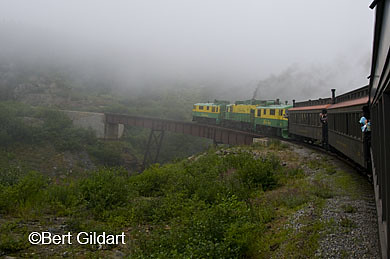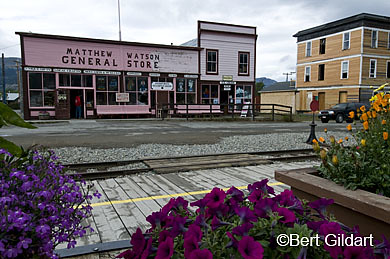Hop Aboard A Narrow Gage Railroad to Relive Stampeder’s Rush to the Klondike
©Bert Gildart: Just as the outbreak of World War II ended the Great Depression of the 1930s, so the Klondike Gold Rush ended the depression of the late 1890s.
In 1896 George Washington Carmack, Skookum Jim and Tagish Charlie discovered gold on Rabbit Creek, a tributary of the Klondike, located not far from where the Yukon and Klondike rivers converge near Dawson, Yukon Territory. Word went out, and the rush was on. The problem, however, was getting to the Klondike, and that’s when enterprising businessmen began creating routes.
Of the half dozen or so different routes to emerge, the two most popular were the Chilkoot and the White Pass, both located near Skagway, Alaska.
DEVELOPMENT OF ROUTES
The Chilkoot developed from a town known as Dyea, located about six miles from Skagway, and for awhile it was considered the preferred route. White Pass was accessed from Skagway, and though it was 600 feet lower, it was 10 miles longer. For that reason, the Chilkoot was the preferred route, and beginning in 1898 and for several years thereafter, over 30,000 gold seekers toiled up this route’s “Golden Stairs,” a hellish quarter-mile climb gaining almost 1,000 vertical feet.
But there was yet another route, and today, you can sit back in comfort aboard the White Pass and Yukon Route Railroad, and experience much of what yet another group of gold seekers experienced. Rails reached White Pass Summit in February of 1899, and from then on, the Chilkoot’s days as the route to the Klondike were numbered. The four-hour round trip excursion courses through history and through some of the Yukon’s most spectacular country.
TRAIN TO WHITE PASS
Janie and I boarded the train about 8 in the morning, and several powerful diesel engines began pulling about 20 cars along the narrow gage tracks. Soon we passed our campground, and could see our Airstream. The rails continued, soon passing the train yard where the historic steam engine Number 73 sat waiting until the weekend during which time it runs faithfully.
Moments later, we passed the Gold Rush Cemetery and a narrator explained over the loud speaker that by 1898 Skagway had become a lawless town. In fact, the town became so lawless that Skagway began to lose traffic to Dyea, the nearby town competing for business. The outlaw faction was led by “Soapy” Smith and for several years, he controlled Skagway. In 1898, Frank Reid, a surveyor, killed Smith in a shootout. Unfortunately, Reid was also shot and he died 10 days from a painful wound in the groin.
Click on each image to see a larger version. L to R: White Pass shack, where the RCMP once waited; trail passes many falls and river, such as the Skagway River; another train along the route to White Pass; our train returns, amidst some sunshine.
As a photographer, the best place to position myself while on the train was on the front and rear platforms. Here, I could photograph the sweep of the trail as it rounded corners, and crossed bridges. From one place, we could look back and see the ocean and we could see Skagway. As well, we could see several huge cruise ships anchored in the harbor. In fact, most aboard the train were from the several ships.
FOG ADDS DRAMA
Typically, the mountain region was foggy, but I thought images of the engine entering the fog added drama, and it helped to better convey the message that this land crossed by the miners was wet and damp. Undoubtedly, the wetness contributed to the variety of illnesses so many miners contracted. Interestingly, scurvy was a leading cause of disease, resulting in general lassitude, loose teeth and bruise-like marks on their bodies. Indians knew a remedy and so did some of the old timers, and that was simply to drink an occasional cup of spruce-needle.
About 10 in the morning, the train neared White Horse Gulch, where over 3,000 horses died, most from abuse. Here, the narrator pointed out that we could also see the old trail, once used by Stampeders.
RCMP MONITORED ACTION OF STAMPEDERS
A few minutes later, the trail entered a second tunnel and then, approached the Summit, which is also the point where the RCMP (Royal Canadian Mounted Police) were stationed to check each of the gold seekers loads. Men were required to have one ton of gear, and much of that was food. The Canadian government knew about the mass starvation experience between 1897 and 1898, “Starvation Winter,” and were determined to prevent a reoccurrence. The RCMP was also posted on the Chilkoot, explaining why it often required months of leap-frog backing to make it to the head of the Yukon, for packs and progress were monitored.
From the headwaters of the Yukon, as mentioned in previous posts, Stampeders would build boats, and then travel about 500 miles down river to the site of the gold discover at Dawson, Yukon Territory.
All too soon, we reached the 2,888 foot high White Pass. Here, passengers are asked to flip their seats so that they are then facing in the direction the train proceeds on its return. Though the return duplicates the country we’d just seen, on the return I knew some of the features I’d missed on the way up and was prepared. I photographed clouds lifting over the hills and the many tributaries of the Skagway River.
We count the trip as one of the most historic and informative in Skagway and highly recommend it.
_____________________________________________________
THIS TIME THREE YEARS AGO:
*The Citadel, Preserving Quebec’s Peace
ADS FROM GOOGLE AND AMAZON AUGMENT OUR TRAVELS:







